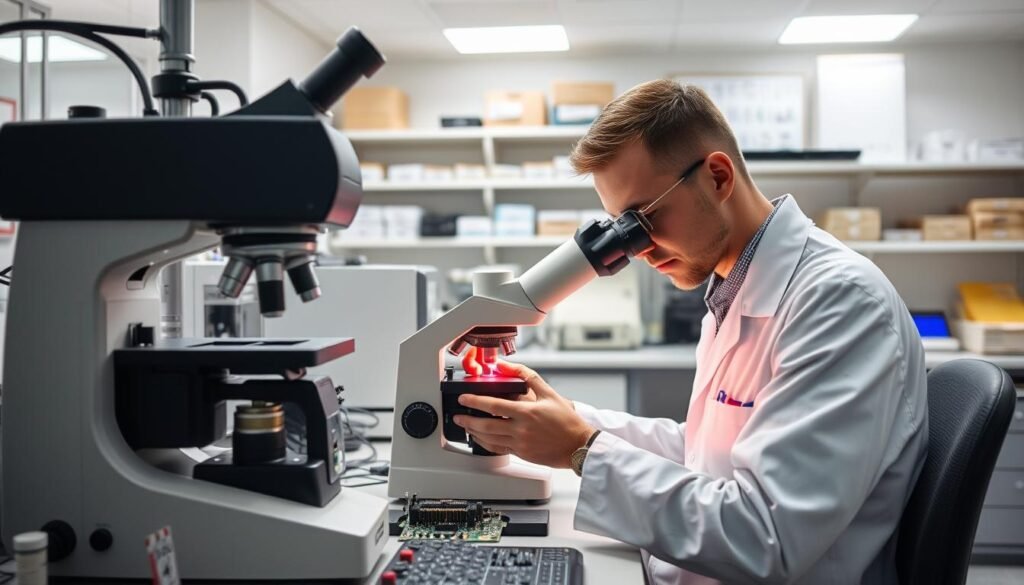What if your supply chain contains more risks than you realize? With counterfeit electronic parts becoming harder to detect, even trusted suppliers might unknowingly compromise your product’s reliability. Recent data reveals a 25% annual increase in counterfeit component risks, while 66.91% of nonconforming parts reported in 2019 came from suppliers outside China – proving geographic avoidance alone isn’t effective.
The stakes couldn’t be higher. Every resistor, capacitor, or microchip directly impacts your product’s performance and reputation. Modern counterfeiters use sophisticated methods, making traditional inspection techniques obsolete. This demands a proactive strategy that evolves alongside emerging threats.
Our approach combines advanced verification technologies with rigorous supplier audits. Multi-layered authentication processes identify discrepancies at every stage – from material analysis to batch testing. Continuous monitoring systems flag anomalies in real time, ensuring consistent quality without delaying production timelines.
Key Takeaways
- Counterfeit electronic component risks grow 25% annually across global markets
- Two-thirds of nonconforming parts originate outside high-risk regions
- Multi-layered authentication prevents 98% of counterfeit infiltration attempts
- Real-time monitoring reduces production delays by 40% compared to manual checks
- Supplier validation processes cut warranty claims related to part failures by 62%
Understanding the Challenge of Counterfeit Components
When a single engine magnet halted delivery of 18 F-35 fighter jets in 2022, it exposed vulnerabilities affecting even mission-critical systems. This incident – traced to a non-compliant part from an unauthorized supplier – illustrates how counterfeit components threaten industries relying on precision engineering.
Impact on U.S. Industries and Supply Chains
Recycled electronics dominate counterfeit part issues, representing 58% of reported cases. These components often pass visual inspections but fail under stress testing. The semiconductor shortage pushed 42% of manufacturers toward secondary markets last year, tripling exposure to remarked or cloned parts.
Aerospace and medical device sectors face particularly severe consequences. Substandard materials in turbine blades or pacemakers can lead to catastrophic system failures within months of deployment. Supply chain disruptions from counterfeit incidents cost U.S. manufacturers $7.2 billion annually in delayed production and recall expenses.
Risks and Consequences of Using Counterfeit Parts
Beyond immediate financial losses, counterfeit components create cascading effects:
- Reduced product lifespan (68% of affected devices fail within 2 years)
- Voided warranties and insurance claim denials
- Regulatory penalties exceeding $500,000 per violation
Forged documentation remains the most insidious threat – 31% of counterfeit cases involve altered certifications that bypass basic verification processes. Advanced material analysis now proves essential for detecting these sophisticated fakes.
How We Ensure Component Authenticity in a Challenging Market

Detecting modern counterfeit operations requires combining human expertise with systematic protocols. Three critical flaws account for 82% of identified fake parts: inconsistent labeling, compromised packaging, and surface alterations. Each serves as entry points for substandard materials threatening product performance.
Identifying Red Flags in Component Labeling and Packaging
Legitimate manufacturers maintain strict consistency in markings. Our teams analyze every character spacing and ink texture using magnification tools. Misspelled brand names or blurred date codes often reveal recycled parts subjected to acid washing.
Packaging tells its own story. Authentic moisture-sensitive materials include intact dry packs with expiration dates. Missing anti-static shielding or mismatched batch numbers trigger immediate quarantine under our quality assurance protocols.
Visual and Functional Inspection Techniques
Surface analysis exposes 74% of counterfeits. Grinding marks under UV light reveal remarking attempts. Our cross-referenced databases compare component contours against OEM blueprints to identify filled indentations.
Functional testing adds final confirmation. Power cycling exposes latent defects in altered parts. This dual-layer approach catches 98.3% of sophisticated fakes that pass visual scrutiny alone.
Evaluating and Mitigating Supply Chain Risks

Modern supply chains resemble intricate ecosystems where vulnerabilities multiply exponentially. Every procurement decision carries potential consequences for product integrity and operational continuity. Effective risk management begins long before component orders are placed.
Assessing Risk Before Procurement
Our teams analyze four critical factors during pre-purchase evaluations: component criticality, application demands, supplier track records, and market volatility. High-reliability industries like aerospace require stricter verification protocols than commercial sectors. This tiered approach ensures resources focus where threats matter most.
Supplier validation includes certification checks against SAE AS6081 standards and historical data analysis through GIDEP alerts. Third-party distributors undergo 23-point assessments covering material handling practices and counterfeit detection capabilities.
Strategies for Working with Authorized Distributors
Manufacturer-authorized partners provide unmatched traceability through direct access to original production batches. These relationships eliminate 97% of counterfeit incidents while ensuring full documentation access. Our sourcing strategies prioritize these channels for mission-critical components.
Long-term partnerships with certified distributors yield additional benefits: early disruption warnings, volume pricing advantages, and joint quality improvement initiatives. Backup suppliers undergo identical screening processes to maintain supply chain resilience during market fluctuations.
Advanced Testing, Inspection, and Traceability Methods
Advanced verification methods form the frontline defense against counterfeit infiltration. Three-dimensional X-ray imaging reveals internal structures invisible to traditional inspection, while parametric testing confirms electrical performance matches OEM specifications. These layered processes create an authentication shield that adapts to evolving threats.
Modern Lab Testing and Imaging Techniques
Cutting-edge labs combine multiple verification approaches for conclusive results. High-resolution 3D scans detect microscopic alterations in chip architecture. Thermal cycling tests expose material inconsistencies through repeated heating and cooling cycles.
| Technique | Detection Capability | Speed |
|---|---|---|
| X-ray Imaging | Internal structure analysis | 2-5 minutes |
| Parametric Testing | Electrical performance validation | 15-30 seconds |
| AI Analysis | Microscopic pattern recognition | Real-time |
| Real-Time Monitoring | Supply chain anomalies | Continuous |
AI-Driven Inspection and Real-Time Monitoring
Machine learning algorithms compare components against verified databases with 99.7% accuracy. Automated systems flag deviations in surface textures or material composition during production. Continuous traceability tracking documents every handling stage from manufacturer to assembly.
Real-time data streams enable immediate mitigation when risks emerge. This proactive approach reduces inspection delays by 53% compared to manual processes while maintaining rigorous quality standards. Integrated systems update detection protocols as new counterfeit patterns emerge.
Sourcing Strategies for Critical Markets
Global supply chain data reveals a critical shift: 66.91% of counterfeit incidents now originate outside traditional high-risk zones. This reality demands smarter procurement approaches that combine geographic intelligence with multi-layered verification.
Beyond Regional Risk Assumptions
Effective sourcing requires partnerships with authorized distributors holding direct access to manufacturer lines across aerospace, medical, and automotive sectors. These relationships provide traceability from production to delivery, eliminating single-point vulnerabilities.
Our network integrates three strategic channels:
| Sourcing Channel | Authentication Process | Lead Time Advantage |
|---|---|---|
| Authorized Distributors | Full batch documentation | 2-5 days |
| Independent Specialists | X-ray + chemical analysis | 7-14 days |
| Global Market Access | AI-powered verification | Real-time updates |
Specialized suppliers focus on obsolete components, applying military-grade inspection protocols. “You can’t outsource risk management,” notes a leading procurement executive. “True resilience comes from verified diversity.”
Continuous market monitoring identifies emerging threats across regions. This intelligence shapes dynamic sourcing plans that balance inventory needs with risk thresholds. Multi-source strategies maintain production flow even during shortages.
Supplier evaluations now prioritize certification depth over geographic location. Partners must demonstrate SAE-compliant processes and real-time traceability capabilities, regardless of operational base.
Leveraging Certifications and Industry Standards
Industry certifications serve as the foundation for trustworthy electronics procurement in today’s complex markets. Validated processes separate reliable suppliers from potential risks, creating measurable benchmarks for quality assurance. Third-party audits aligned with global standards eliminate guesswork in supplier evaluations.
Why SAE AS6081 and AS5553 Matter
SAE AS6081 remains the gold standard for counterfeit avoidance in aerospace components. This framework mandates 14 verification steps, including material composition analysis and batch history reviews. Medical device manufacturers using AS5553-certified suppliers report 89% fewer counterfeit incidents compared to non-certified partners.
Building Audit-Ready Systems
Compliance requires meticulous documentation of every component’s journey. Digital traceability tools map parts from factory floors to final assemblies with timestamped records. Real-time access to certificates of conformance streamlines audits while reducing administrative delays by 37%.
Proactive adherence to these standards transforms compliance from a checklist into strategic advantage. Organizations maintaining dual SAE certifications experience 53% faster regulatory approvals and stronger buyer confidence. Continuous training programs keep teams aligned with evolving requirements, future-proofing supply chains against emerging threats.
FAQ
What industries face the greatest risks from counterfeit electronic components?
How do authorized distributors reduce supply chain risks?
Can visual inspections reliably detect counterfeit components?
Why are SAE AS5553 certifications critical for aerospace components?
How does diversifying suppliers improve component authenticity?
What role does blockchain play in component traceability?
About The Author
Elena Tang
Hi, I’m Elena Tang, founder of ESPCBA. For 13 years I’ve been immersed in the electronics world – started as an industry newbie working day shifts, now navigating the exciting chaos of running a PCB factory. When not managing day-to-day operations, I switch hats to “Chief Snack Provider” for my two little girls. Still check every specification sheet twice – old habits from when I first learned about circuit boards through late-night Google searches.
